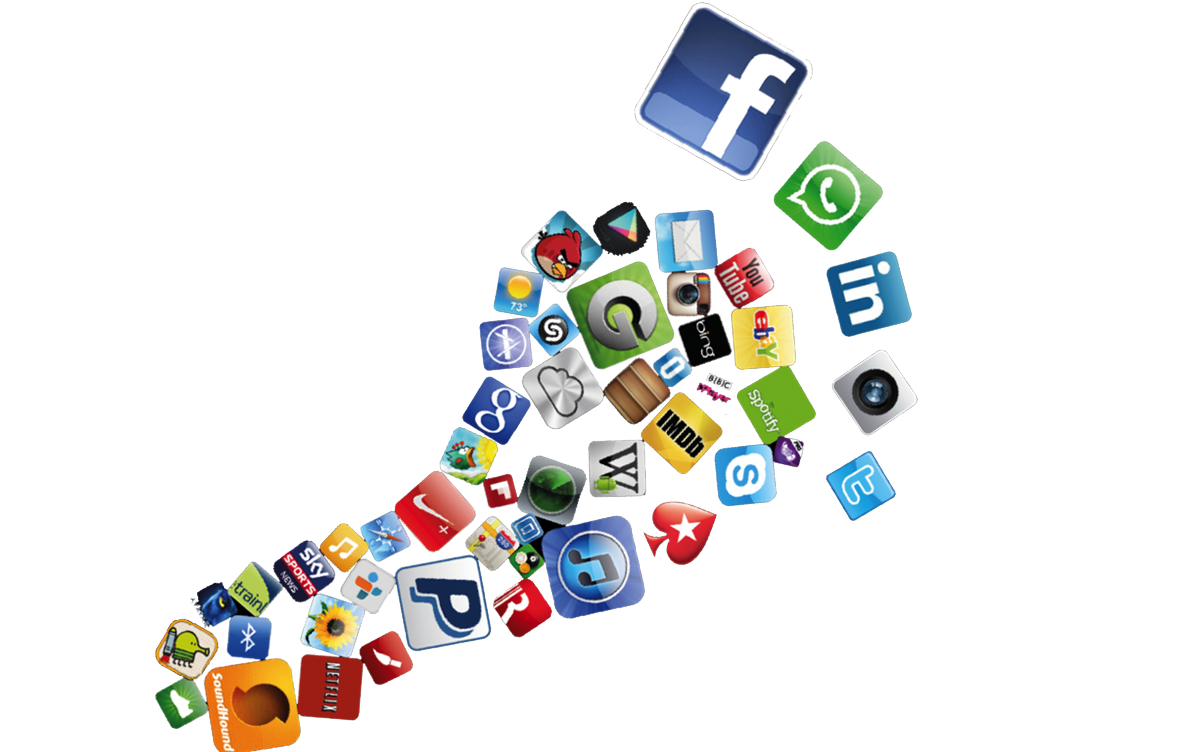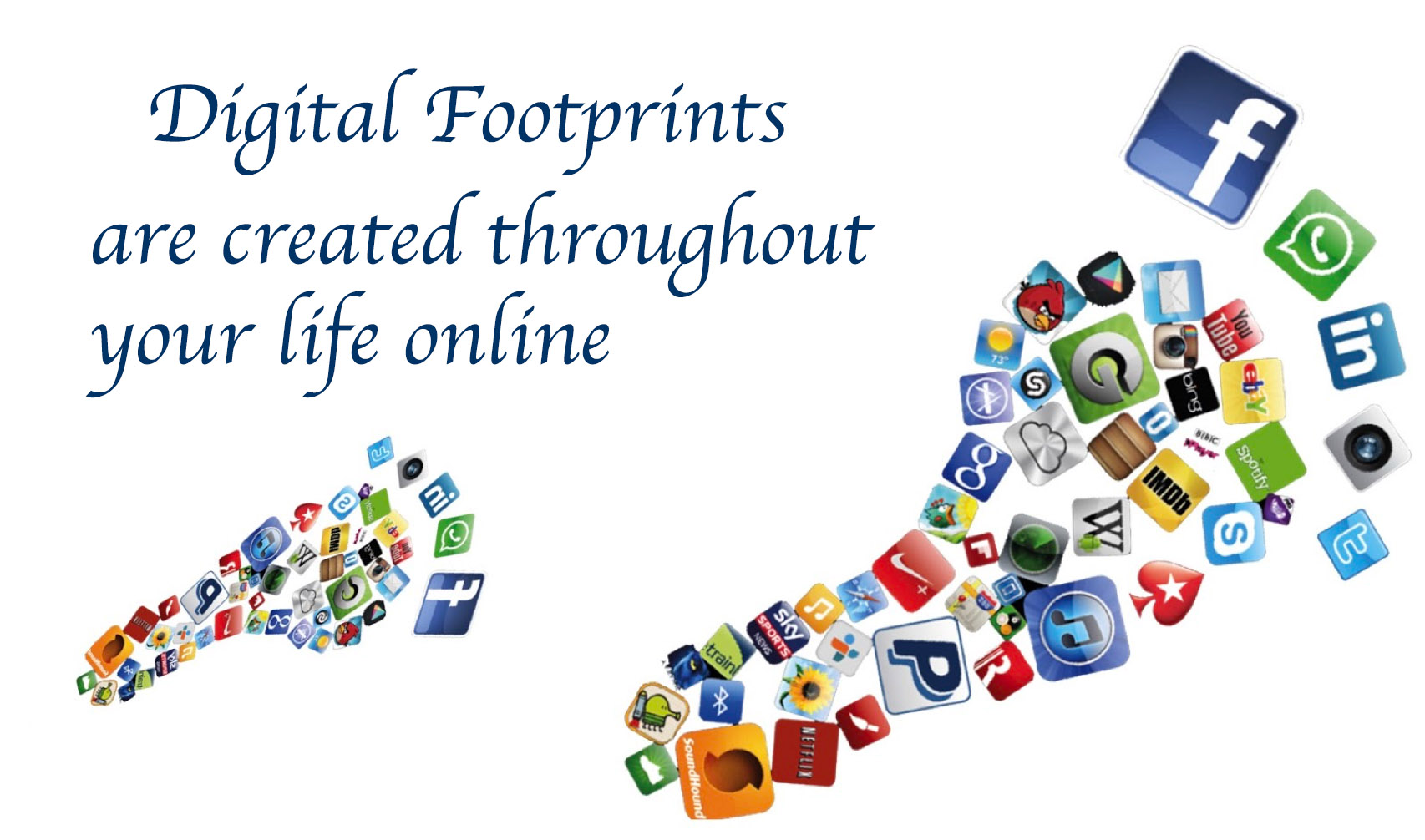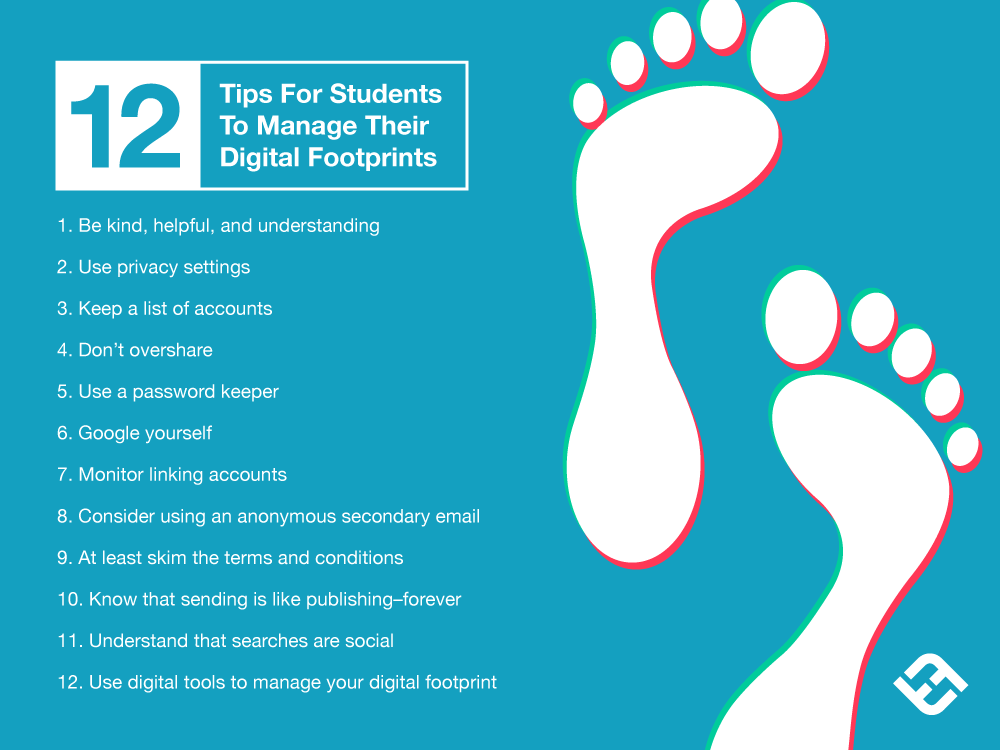A Digital Footprint

Direct link to the video Four Reasons to Care About Your Digital Footprint (8:01) on YouTube
Link to the Internet Society Lessons Page this is used in
Introduction
The video above presents information about how one's actions and choices online and in social media can affect your life and future choices. In this section you will explore what a Digital Footprint is, reflect on your own footprint, and consider positive actions and attitudes we can take to make a difference for teaching and learning.
Throughout this section we hope you will refer to the following items located on the right-side in expandable content blocks:
- List of vocabulary terms
- ISTE technology standards for Educators and Education Leaders
- Michigan Technology competencies for students, and ISTE student standards
- A compilation of teaching lessons and resources for K-12 settings.
Questions for Reflection:
- How are digital footprints created?
- What does yours show about you?
- Who can see it and how is your information used by others?
- How can you deliberately create a positive and professional representation online?
- How can you help students reflect on their own digital footprint and online presence, and the value and benefits of the choices they make for themselves and significant others?
Steps:
1.. Use the resources provided on the right-hand menu, and those below to find information and resources that help answer the questions posed above and some of your own.
About a Digital Footprint

Image: Created from images free to use and modify by C. McCarthy https://technofaq.org/posts/2018/11/guide-to-tracking-your-digital-footprint/ Image source 1/12/2020
2. Learn about and then reflect on different ways a digital presence impacts one's life, job, and future choices. Select and explore a few of the following resources to get a clear view on the scope of this:
-
Digital Footprint (3:20)
-
Interesting Facts on Digital Footprints and Reputation (EdTech Review 3/1/2017)
-
ABC News Video Harvard Admissions Bombshell
-
Algorithms and your Digital Footprint video (2:33) from CommonCraft.
- 12 Tips For Students To Manage Their Digital Footprints from TeachThought

Your Own Digital Footprint
3. Now it's time to look at your own digital footprint and reflect on it:
- There are a wide variety of $ pay for services online with a monthly charge, but some do not provide very accurate information.
- The GoodHire site offers information about 'How to run a background check on yourself'. It identifies the different types of public records that can be referenced and several National databases. Searching public records can be time consuming and are more geographically oriented. It also has pricing for their services.
- Caution: An internet search can get some information, however it is not always dependable.
- Google your own name and include the state. Run a quick search on a few different browsers that use different search engines and make a note of any website domains that flag you, social media account links, YouTube videos, and anything else of interest.
- Think about the specific footprints or information you have left behind on the sites you access. Check the social media sites. If this was the only information someone knows about you, what would they think about you? What assumptions would they make about your habits & behaviors?
- If you have your own blog, podcast, social site, or webpage, what do these show about you?
- If you were to apply for a job, what would a potential employer learn about you?
- What would you like it to show in 5 years? In 10 years?
4. Proactive Actions you can take:
- Set up Google alerts for when your name appears online.
- Limit the personal information you provide online
- Think twice before you post and avoid posting during temporary emotional times (like angry or confrontational about something or someone).
- Think twice about the photos and images you share (could they be used and edited by others in an unflattering way).
- Be intentional and professional.
5. Competencies and Standards: Open the section on the right-hand column on this page for the ISTE Technology Standards for Educators and Education Leaders. Which Educator, or Education Leader, standards do you model, or want to focus on in your classroom or educational setting?
6. Make a difference: Take what you have learned and select someone to share it with. You might choose to discuss what your school or educational setting does to educate others about a digital footprint and digital citizenship, make a presentation to your fellow staff, or create a lesson or activity for your students.
Wizard of Apps - Enjoy!
This is a clip from the K12 Online Conference
Presentation Title: The Wizard of Apps or Will they have an app for that? or What we are learning and loading along the road
Presentation Description: In this student-produced keynote, Joyce (Valenza) and the students of Springfield Township High School’s Theatre II class consider which apps are the most critical as they walk the road together.
As you looked at your own digital footprint, reflect on:
- How you can be more intentional about what information you post and share online.
- How you can help students understand the value and benefits of the digital footprint and presence they create and share online.
Continue on to Teaching & Learning in a Digital Age
Vocabulary
Vocabulary
2FA: Two Factor Authentication
2FA is a fancy name for adding an extra verification step to the login process of your most critical accounts. Instead of just providing your username or password to log in, a secondary form of verification is required to prove your identity. One way to do this is by receiving a one-time code that’s texted to your phone. Another is to use an authenticator app like Google Authenticator.
Cookies: Small text files (strings of alphabet letters and numbers) a website sends to your computer that keeps track of what a person does on a website.
Digital Citizenship: The ability to use digital technology and media in safe, responsible and effective ways.
Digital Creativity: The ability to become a part of the digital ecosystem by co-creating new content and turning ideas into reality by using digital tools.
Digital entrepreneurship: The ability to use digital media and technologies to solve global challenges or to create new opportunities.
IP Address: An IP address, or simply an "IP," is a unique address that identifies a device on the Internet or a local network. It allows a system to be recognized by other systems connected via the Internet protocol.
Online Tracking: Apps, websites, or third parties collecting information about your online activity (other sites you visit, links you click, how long you stay, etc.).
Personalized Content: Online information tailored to you by websites and apps based on your behavior and preferences about you.
Third Party: A company other than the company that owns the website or app you're using.
Targeted Advertising: Websites or apps selling you something based on information they have collected about you.
ISTE Technology Standards for Educators and Education Leaders
Addressing the ISTE-E and ISTE-EL (International Standards for Technology in Education - For Educators and Education Leaders)
1. Learner
a. Set professional learning goals to explore and apply pedagogical approaches made possible by technology and reflect on their effectiveness.
2. Leader
b. Advocate for equitable access to educational technology, digital content and learning opportunities to meet the diverse needs of all students.
c. Model for colleagues the identification, exploration,
evaluation, curation and adoption of
new digital resources and tools for learning.
3. Citizen
a. Create experiences for learners to make positive, socially responsible contributions and exhibit empathetic behavior online that build relationships and community.
b. Establish a learning culture that promotes curiosity and critical examination of online resources and fosters digital literacy and media fluency.
c. Mentor students in safe, legal and ethical practices with digital tools and the protection of intellectual rights and property.
d. Model and promote management of personal data and digital identity and protect student data privacy.
ISTE-EL standards target the knowledge and behaviors required for leaders to empower teachers and make student learning possible.
1. Equity and Citizenship Advocate
c. Model digital citizenship by critically evaluating online resources by engaging in civil discourse and using digital tools to contribute to positive social change
d. Cultivate responsible online behavior, including the safe, ethical and legal use of technology.
4. Systems Designer
c. Protect privacy and security by ensuring that students and staff observe effective privacy and data management practices.
5. Connected Learner
c. Use technology to regularly engage in reflective practices that support personal and professional growth.
MITECS Competencies and ISTE Technology Standards: for Students
MITECS Michigan Integrated Technology Competencies for Students, and
1. Empowered Learner
a. Articulate and set personal learning goals, developing strategies leveraging technology to achieve them, and reflect on the learning process itself to improve learning outcomes
2. Digital Citizen
a. Students cultivate and manage their digital identity and reputation and are aware of the permanence of their actions in the digital world
b. Students engage in positive, safe, legal and ethical behavior when using using technology
d. Students manage their personal data to maintain digital privacy and security
Classroom Lessons and Resources
Explore the lessons and resources below that might apply to your own setting and that might be useful resources for you own final assignment artifact:
Students can create drawings, graphics, videos, posters, write stories, etc.
Videos: Two short videos created by students with tips.
Lesson Resources from REMC 21things4students and MiTechKids
Middle School
Digital Footprint
Early Elementary
Follow the Digital Footprints Kindergarten lesson
3rd Grade lesson Digital Footprint
Lesson Resources from Common Sense Education:
Grade 2 Social Media and Digital Footprint Our Responsibilities
Grade 4 Our Online Tracks
Grade 7 The Power of Digital Footprints
Grade 8 & 9 Social Media and Digital Footprints - Our Responsibilities
Grade 11 Whos Looking At Your Digital Footprint
Example of an activity to create a Digital Footprint Representation

You might find it helpful and fun to make a diagram (or jot down) what your own digital footprint looks like, and make things you spend the most time on stand-out (large and bold font perhaps or icons like in the image above).
- Copy and use one of these footprint documents (foot PDF Document, or Google Doc footprint slide to copy and use ). (OPTION: if you don’t want to print the footprint or your printer isn't working, you may grab a piece of 8 ½ x 11 paper, trace around your foot with a pencil and write your list in your hand-traced footprint).
- Use a graphic organizer such as Popplet or Bubbl.us
- Use a Word Cloud where the more times you list the same item, the larger it will appear in the cloud:
